Live on the homepage now!
Reader Supported News
Ukraine’s reconstruction will be a decades-long effort requiring the participation of a new generation of leaders capable of realizing the Ukrainian dream of European integration, prosperity, and democracy; yet nearly 700,000 Ukrainian students and 25,000 educators have been displaced since Russia’s invasion (World Bank). Over 2,400 Ukrainian schools have been damaged and over 330 educational institutions have been destroyed. In occupied territories, Russians are taking over school curricula with Russian propaganda.
In the wake of this disruption, we can help Ukrainians continue their educations by granting scholarships for Ukrainians to study at U.S. colleges and universities. In doing so, we can empower Ukrainian youth with the skills required to return home to rebuild Ukraine as a democracy that pays tribute to the enormous sacrifice of their people as they defend not only their homes but also the Free World as a whole. The benefits of this exchange are not just to offer Ukrainian scholars a chance to continue their educations, but also to educate American scholars by Ukrainian example. In addition to providing Ukrainian scholars a reprieve from the war upending their futures, we can create the opportunity for them to engage with their American peers who have the potentially short-lived luxury of waking up without the fate of democracy on their minds.
We Americans are in desperate need of Ukraine’s reminder of the freedom that is a stake and the courage required to defend that freedom. Here at home, democracy is increasingly threatened by radical positions on both sides. On the left, rigid ideology, judgementalism, and cancelling increasingly impinge on freedom of speech. On the right, a dangerous cult of personality is eroding rule of law and feeding violence. As both extremes gain ground, they eat the mainstream. In this climate, imagine what American youth could learn from their international peers, especially those in Ukraine whose people are laying down their lives for the democracy that we in the U.S. are at increasingly allowing to slip away.
The three of us have proudly made America our adopted home after emigrating or seeking asylum. We have experienced life in undemocratic nations where basic rights like freedom of speech and due process of law did not exist or were repressed. Through our foreign policy, humanitarian, and peace-building work, we know that democracy does not live in a bubble. To believe that Ukraine’s fight for freedom and our own are not deeply interconnected is short-sighted and dangerous. The result of Ukraine’s epic battle will shape not only the future of Europe, but also of American democracy. When democracy loses anywhere in the world, it is weakened everywhere. When democracy wins in one nation, all democracies get stronger.
The future of the free world will depend on our ability to build strong global alliances in support of democracy. Those alliances can begin on campuses across the world where young people are coming together across national boundaries to exchange ideas, shape one another’s worldviews, and learn not just from the history in their textbooks, but also from the history being written in our world today. Among the conversations they share about climate change, social justice, and economic models should be the ones concerning today’s threatening rise of authoritarianism and populism, and the actions required from all citizens to make a democracy work.
We believe we speak on behalf of legions of freedom-fighters when we say that, despite its imperfections, America remains a beacon of hope for democracy the world over. Let us learn from what Ukrainian youth can teach us and let us support their epic battle. Their victory will be our own, but only if we step into our power and responsibility to play a role.
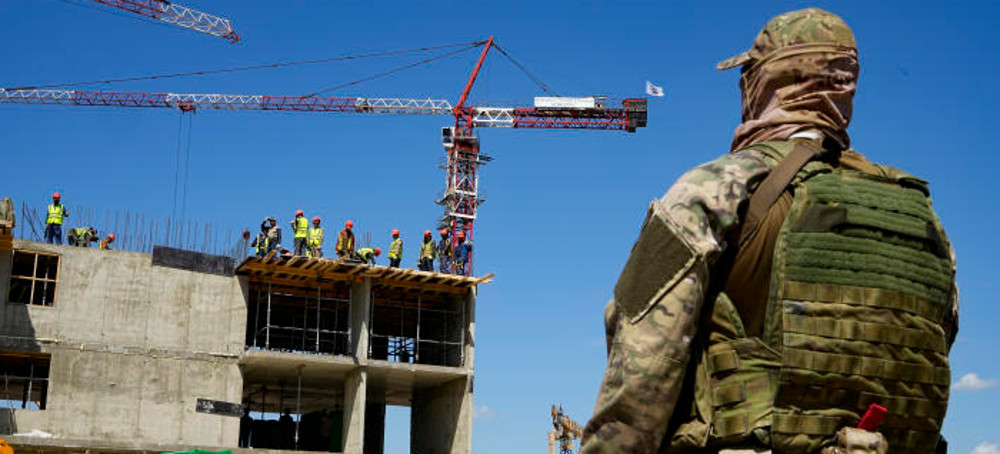 A Russian soldier guards the site of a new apartment building which is is being built with the support of the Russian Defense Ministry, in Mariupol, in territory under control of the government of the Donetsk People's Republic, in eastern Ukraine, Wednesday, July 13, 2022. (photo: AP)
A Russian soldier guards the site of a new apartment building which is is being built with the support of the Russian Defense Ministry, in Mariupol, in territory under control of the government of the Donetsk People's Republic, in eastern Ukraine, Wednesday, July 13, 2022. (photo: AP)
Russian military convoys rumble down the broad avenues, and Russian soldiers, builders, administrators and doctors are replacing the thousands of Ukrainians who have died or left.
Eight months after Mariupol fell into Russian hands, Russia is eradicating all vestiges of Ukraine from it – along with the evidence of war crimes. The few schools still open teach a Russian curriculum, phone and television networks are Russian, the Ukrainian currency is fading away, and Mariupol is now in the Moscow time zone. On the ruins of the old Mariupol, a new Russian city is rising, with materials from at least one European company, The Associated Press found.
But the AP investigation into life in occupied Mariupol also underlines what its residents already know all too well: No matter what the Russians do, they are building upon a city of death. More than 10,000 new graves now scar Mariupol, the AP found, and the death toll might be three times higher than the government-in-exile’s early estimate of at least 25,000. The former Ukrainian city is also hollowing out, losing well over 50,000 homes, the AP calculated.
___
Associated Press journalists were the last international media in Mariupol to escape heavy shelling in March, before Russian forces took the city over. This is the story of what has happened since. AP reconnected with many people whose tragedies were captured in photos and video during the deadliest days of the Russian siege.
___
Every person the AP spoke to knew someone killed during the siege of Mariupol, which began with the Feb. 24 invasion. As many as 30 people arrive at the morgue each day in hopes of tracking down a loved one.
Lydya Erashova watched her 5-year-old son and her 7-year-old niece die after a Russian shelling in March. The family hastily buried the cousins in a yard and fled Mariupol.
They returned in July to rebury the children, only to learn that the bodies had been dug up and taken to a warehouse. As they approached the city center, each block was bleaker than the last.
Erashova, who is now in Canada, said no Russian rebuilding plan could possibly bring back what Mariupol lost.
“It’s so ridiculous and stupid. How do you restore a dead city where people were killed at every turn?” she asked.
The AP investigation drew on interviews with 30 residents from Mariupol, including 13 living under Russian occupation; satellite imagery; videos gathered from inside the city, and Russian documents showing a master plan.
Mariupol was in the crosshairs of the Kremlin from the first day of the invasion. Just 40 kilometers (25 miles) from the Russian border, the city is a port on the Sea of Azov and crucial for Russian supply lines.
The city was hit relentlessly with airstrikes and artillery, its communications severed, its food and water cut off. By the time the last Ukrainian fighters s urrendered in the Azovstal steel mill in May, Mariupol had become a symbol of resistance.
An AP analysis of satellite imagery taken over the past eight months of occupation shows 8,500 new graves in the outlying Staryi Krym cemetery, with possibly multiple bodies beneath each mound. There are at least three other trench gravesites around the city, including one created by Ukrainians at the beginning of the siege.
In all, a total of at least 10,300 new graves are scattered around Mariupol, according to AP’s methodology, confirmed by three forensic pathologists. Thousands more bodies likely never even made it to the graveyard.
Back in May, the municipal government in exile estimated 25,000 people at a minimum had died. But at least three people in the city since June say the number killed is triple that or more, based on conversations with the workers documenting body collection for the Russian occupation authorities.
In a review of hundreds of photos and video clips along with documents from occupation authorities, the AP found that more than 300 buildings in Mariupol have been or are about to be demolished. Most are multistory apartment blocks, with around 180 apartments inside or more.
In all, the demolitions will remove well over 50,000 homes, according to AP calculations.
“People still live in the basements. Where they can go is unclear,” said an activist in Mariupol, who requested anonymity for fear of disappearing into Russian custody.
Russia is now moving into the historic city center. Russian authorities dismantled Mariupol’s memorial to victims of the Holodomor, the Soviet-engineered famine in the 1930s that killed millions of Ukrainians, according to video posted on Russian television. They painted over two murals commemorating victims of Russia’s 2014 attack on Ukraine.
Russia already has constructed at least 14 new apartment buildings — a small fraction of the number coming down — and is repairing at least two of the hospitals it damaged by shelling. Video obtained by the AP showed rows of pallets stacked with insulation from the Danish company Rockwool, which maintains its division in Russia despite criticism.
Rockwool’s Vice President of Communications Michael Zarin said the insulation panels were distributed without the company’s “knowledge or consent.”
Videos show no furniture visible in the windows of the new apartments and few people on the sidewalks outside. Only pensioners, the disabled and those affiliated with the occupation seem to be getting them, according to multiple people in Mariupol.
One man applied to the list in September and found himself in 11,700th place. He has friends in the 2,000 range who are still waiting, like him. And an old man he knows whose number was in the 9,000s has already moved into one of the new buildings.
However, the man said he has no issue demolishing buildings that aren’t fit to live in, and he's relaunching his own business.
But the plans for a Russian Mariupol depend on a population that simply no longer exists.
Thousands of Mariupol’s former residents were sent to Russia with little or no choice, and thousands more fled into other areas of Ukraine. Of Mariupol’s former population of around 425,000, just over a quarter stayed, according to estimates from Petro Andryushchenko, an aide to Mariupol’s mayor who is exiled in Dnipro.
The Russian master plan for Mariupol calls for a population of 212,000 in 2022, and back to 425,000 by 2030. Right now, about 15,000 of the people in Mariupol people are Russian troops, said Andryushchenko, who drew his estimate from information about the soldiers taking over homes and public buildings. He said Russian riot police now patrol to head off protests against the lack of heat, electricity and water.
READ MORE  Internal emails showed the company's communications with the Pentagon over a network of military-run accounts. (photo: iStock)
Internal emails showed the company's communications with the Pentagon over a network of military-run accounts. (photo: iStock)
Internal emails showed the company’s communications with the Pentagon over a network of military-run accounts.
A counterterrorism division at Twitter knew about the arrangement, but others did not, five people with knowledge of the matter said. When it became more widely known within the company, executives rushed to undo it. But they struggled with whether to publicly disclose the military-run Twitter accounts, the people said.
Some of the accounts were removed, but others remained online for years. Twitter eventually disclosed the U.S. influence campaign this year.
READ MORE 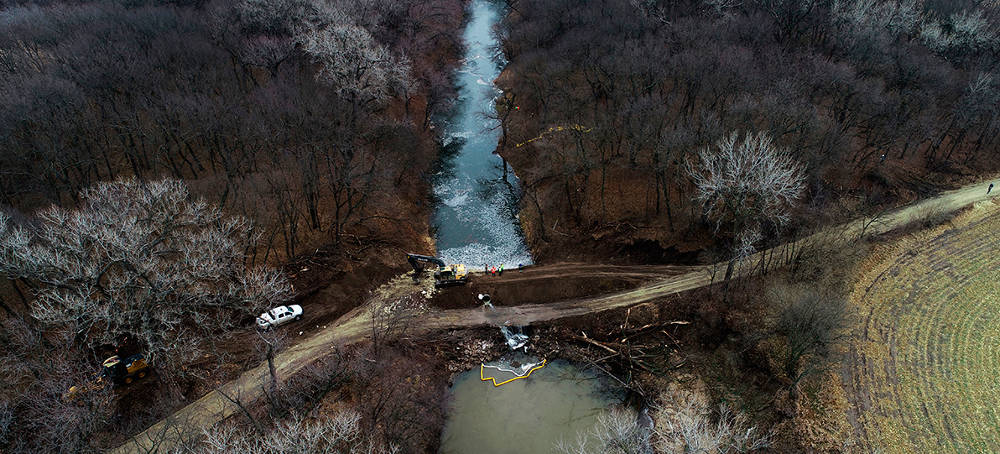 An investigation into the pipeline's largest spill is under way in Kansas as a recent report points to a deteriorating safety record. (photo: Reuters)
An investigation into the pipeline's largest spill is under way in Kansas as a recent report points to a deteriorating safety record. (photo: Reuters)
An investigation into the pipeline’s largest spill is under way in Kansas as a recent report points to a deteriorating safety record
It is also the case that previous estimates from earlier spills on the pipeline have turned out to be much larger than the initial estimates.
Four dead mammals and 71 dead fish were recovered from the latest spill site, according to the Environmental Protection Agency, which is involved in cleanup efforts with the US Pipeline and Hazardous Materials Safety Administration (PHMSA), state and local agencies, the pipeline owner and operator TC Energy and the company’s contractors. About 5,500 barrels of oil and water and 5,000 cubic yards of oil-contaminated soil have been recovered in initial cleanup efforts.
Most of the undamaged parts of the pipeline resumed operations last week, as cleanup efforts and an investigation into the cause of the spill continue. On Tuesday it was reported that TC Energy had submitted its plan to regulators for fully restarting it.
“That’s our livelihood out here,” Bill Pannbacker, a farmer whose land was affected by the spill, told CBS News. “Probably an acre, an acre-and-a-half of grasses was totally covered with oil. But that’s on a slope so it would run down, and that’s when it ran down into the creek.”
The spill was the largest onshore oil spill since at least 2013 and the largest spill in the Keystone pipeline system since it began operating in 2010.
“Waterways and land should not be put at risk so Canada and big oil can get their product to market,” said Jane Kleeb, founder and president of the Nebraska non-profit Bold Alliance, which helps communities fight fossil fuel projects. Kleeb is also the chair of the Nebraska Democratic party. “It’s a tremendous burden that pipeline companies put on landowners. They not only take their land through eminent domain for the pipeline company’s private gain, they also take an [access] easement forever.”
Kleeb argued these spills demonstrate how unfair the relationship between pipeline corporations and landowners is. She also pointed to how the Keystone pipeline was labeled the “safest pipeline ever built” during the push for approval for the controversial Keystone XL pipeline. The latter was a proposed extension to the Keystone pipeline that was eventually scrapped: its permits were initially revoked by the Obama administration, reinstated by the Trump administration and then canceled by the Biden administration.
“This spill in Kansas is going to take years to clean up. TC Energy currently is pretending that this is going to be a two-week cleanup job and everything’s going to be fine,” added Kleeb. “That topsoil that has now been destroyed on that farmer’s property is gone forever. If you’re in the agriculture industry, you know how precious topsoil is, and how much farmers and ranchers do to protect that topsoil. That’s gone, it’s never coming back, that land will never be the same.”
The crude tar sands oil transported by the Keystone pipeline differs from conventional oil. It consists of a heavy oil called bitumen that is cut with a lighter gas called a diluent to facilitate transportation through pipes.
“Oil spills pose both short and long-term risks to ecological communities,” said Dr Diane Orihel, an assistant professor in aquatic ecotoxicology at Queens University in Kingston, Ontario, Canada. “In the days following a spill, oil exposure can cause acute toxicity in wildlife from oil ingestion, inhalation, smothering, drowning or hypothermia. However, scientists now know that the ecological impacts of oil spills can be far more wide-reaching and persist for decades after the spill.”
Dr Orihel conducted a study on bitumen’s impact on a freshwater lake. She observed that it sinks below the water surface and accumulates on the sediment surface in a matter of hours or days.
She also found the diluted bitumen spill resulted in a strong decline in the abundance of insects emerging from the lake. Meanwhile, only a small percentage of the main contaminants of concern in bitumen – called polycyclic aromatic compounds – dissolved into the water column of the lake.
“This propensity for bitumen to sink in freshwater ecosystems also makes oil cleanup much more challenging,” added Dr Orihel.
Incidents like Exxon Valdez and Deepwater Horizon have showed that oil spills can have large-scale, long-term effects. “Some wildlife populations may take years to recover from the deaths initially caused by the oil spills, but also certain components of oil are persistent and remain in the ecosystem, continuing to be taken up and causing chronic health effects on wildlife,” she says.
Yet, other major spills, like the one linked to the Hebei Spirit, have offered a lesson. “They have taught us that rapid and extensive cleanup of oil spills can help ecosystems to recover from the disturbance and limit the long-term impacts,” Dr Orihel added.
About 22 oil spills have occurred on the Keystone pipeline in the past 12 years, with two other large incidents. TC Energy has only paid $300,000 in fines for previous spills on the Keystone pipeline, even if the spills caused more than $111m in property damage.
“It is a lemon,” said Paul Blackburn, an attorney who specializes in pipeline law with Bold Alliance. “It’s leaked a remarkable number of times and while there may be certain kinds of specific causes for each leak, the fact that it leaks so often suggests that there may be some underlying systemic reasons on what’s going wrong.”
A 2010 report from an environmental law center identified a pattern of production and use of substandard steel in new pipelines amid a pipeline construction boombetween 2007 and 2009. A manufacturer linked to the Keystone pipeline was included.
After construction, the Keystone pipeline received numerous warnings from federal regulators about the lack of corrosion protection and deficiencies in corrosion control. The problems took years to be fixed. A recent US Government Accountability Office (GOA) report noted the Keystone pipeline’s safety record has been deteriorating and identified “construction issues”, resulting in large spills on the Keystone pipeline in 2017 and 2019.
Blackburn argued the possibility of fines levied on pipeline corporations are included in the cost of doing business for these multibillion-dollar corporations, which often pass the costs on to customers if they are not already covered by insurance. He noted regulators can force pipeline corporations to conduct more frequent in-line inspections, such as imaging tools that can perform ultrasounds on pipelines to identify possible points of failure and remedy them before a spill occurs.
“All pipelines leak and depending on where they leak, it can be catastrophic, and it certainly is catastrophic for the people who live there whose land is impacted,” added Blackburn. “There are much better tools to prevent these kinds of leaks and PHMSA should require that they be used more often.”
TC Energy claims 6,973 barrels of oil have been recovered from the creek as of 17 December. “The affected segment of the Keystone Pipeline System remains safely isolated as investigation, recovery, repair and remediation continue to advance,” TC Energy said in a statement. “This segment will not be restarted until it is safe to do so and when we have regulatory approval from PHMSA.”
READ MORE  A Bushmaster semi-automatic assault rifle (top) and a Smith & Wesson semi-automatic rifle are turned in during a gun buyback event at the New Haven Police Academy in New Haven, Connecticut, December 22, 2012. (photo: Michelle McLoughlin/Reuters)
A Bushmaster semi-automatic assault rifle (top) and a Smith & Wesson semi-automatic rifle are turned in during a gun buyback event at the New Haven Police Academy in New Haven, Connecticut, December 22, 2012. (photo: Michelle McLoughlin/Reuters)
The suit filed in the Erie County branch of New York’s Supreme Court alleges firearm companies like Smith and Wesson, Beretta, Remington, Glock, and Bushmaster as well as what the lawsuit terms “ghost gun companies,” including Arm or Ally and Polymer80, contributed to a condition “that endangers the safety and health of the public” of the city.
“Members of our community have suffered too much and for too long from gun violence,” Buffalo Mayor Byron W. Brown said at a news conference Tuesday. “We must do everything we can to decrease gun violence. Enabling the possession of illegal guns destroys lives and deeply affects our neighborhoods, especially in Black and Brown communities.”
The lawsuit comes seven months after 10 people were killed and three were wounded in a racially motivated mass shooting at a Tops Friendly Market in a predominantly Black area of Buffalo.
The gunman, who is White, pleaded guilty last month to one count of domestic act of terrorism motivated by hate, 10 counts of first-degree murder, three counts of attempted murder and a weapons possession charge.
He used a Bushmaster XM-15 in the attack, the same model used by the shooter in the 2012 mass shooting at Sandy Hook Elementary School in Connecticut which resulted in the deaths of 20 first graders and six adults, the lawsuit states.
The city is seeking compensatory and punitive damages from the defendants, including money for an “abatement fund with sufficient capital to eliminate the public nuisance they are responsible for creating, exacerbating, and/or perpetuating,” the lawsuit states.
CNN reached out to the named defendants and the National Rifle Association for comment.
“We have not had a chance to review the allegations in full at this time, but upon first blush, the verified allegations against Bushmaster Firearms Industries, Inc. are false,” gun manufacturer Bushmaster said in a statement. “Our counsel is currently reviewing the complaint and evaluating a path forward to address both this lawsuit and the potentially libelous claims made against Bushmaster Firearms Industries, Inc.”
No other entity returned CNN’s request for comment.
During Tuesday’s news conference Brown said the goal of the lawsuit is not to prevent legal gun ownership, but is instead “another proactive strategy that we are utilizing in Buffalo to keep our community safe.”
City officials cited crime data showing 355 people were killed or injured in shootings in Buffalo in 2020, and said the number of people shot in the city during the first three months of 2021 jumped 140% compared to the same time frame in 2020.
“We have state public nuisance laws that we are empowered to enforce, and I intend on doing all that I can as Mayor to protect people and prevent the loss of lives resulting from gun violence,” Brown said. “The conduct of certain gun manufacturers has unreasonably interfered with the public’s right to use open space free from fear.”
Parents of survivors of the Robb Elementary shooting in Uvalde, Texas, have taken similar legal action against a gun manufacturer and other entities, accusing them in a federal lawsuit of negligence and recklessness.
Nineteen students and two teachers were killed in the May 24 shooting, which was carried out by an 18-year-old gunman.
READ MORE 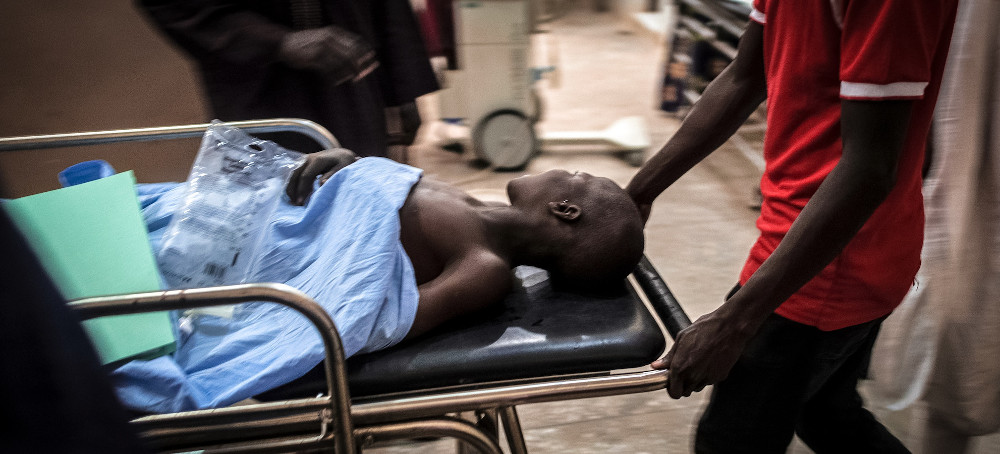 Members of the Nigerian Red Cross receive victims on Jan. 18, 2017, the day after a U.S.-backed airstrike mistakenly killed more than 160 civilians at a displaced persons' camp in Rann, Nigeria. (photo: Stefan Heunis/Getty)
Members of the Nigerian Red Cross receive victims on Jan. 18, 2017, the day after a U.S.-backed airstrike mistakenly killed more than 160 civilians at a displaced persons' camp in Rann, Nigeria. (photo: Stefan Heunis/Getty)
Members of Congress asked the Defense Department to answer questions within 90 days — a deadline that expired almost two weeks ago.
In September, the Protection of Civilians in Conflict Caucus called on Defense Secretary Lloyd J. Austin III to disclose details of the U.S. role in the January 17, 2017, airstrike on a displaced persons camp in Rann, Nigeria. While the Nigerian air force expressed regret for carrying out the attack, which also seriously wounded more than 120 people, it was referred to as an instance of “U.S.-Nigerian operations” in a formerly secret U.S. military document first revealed by The Intercept in July.
Just days after the attack, U.S. Africa Command secretly commissioned Brig. Gen. Frank J. Stokes to undertake an “investigation to determine the facts and circumstances” of the airstrike while avoiding questions of wrongdoing or recommendations for disciplinary action, according to the document, which The Intercept obtained via the Freedom of Information Act. Stokes’s findings were never made public.
The Protection of Civilians in Conflict Caucus — Reps. Sara Jacobs, D-Calif.; Jason Crow, D-Colo.; Ro Khanna, D-Calif.; Andy Kim, D-N.J.; and Tom Malinowski, D-N.J. — asked Austin to turn over the nearly six-year-old investigation and answer a series of questions concerning the attack and U.S.-Nigerian military operations within 90 days; that deadline expired almost two weeks ago.
“The Pentagon’s failure to provide information and documents … to determine possible U.S. involvement in an airstrike that took many civilian lives in northeast Nigeria does not bode well for the U.S. government’s expressed commitment to transparency and accountability,” Anietie Ewang, Human Rights Watch’s Nigeria researcher told The Intercept. “It sends a worrisome message that, at minimum, the Defense Department is unwilling to engage on an issue affecting countless lives and may even reflect an attempt to evade responsibility.”
In August, the Pentagon unveiled a Civilian Harm Mitigation and Response Action Plan, which provides a blueprint for improving how the U.S. military addresses civilian harm. The plan calls for a new emphasis on the “proactive release of information” and “transparency regarding [Defense Department] policies and processes for mitigating and responding to civilian harm” — but not until next year.
The formerly secret AFRICOM document obtained by The Intercept, along with reporting by Nigerian journalists and interviews with experts, suggests that the U.S. may have launched this rare internal investigation because it secretly provided intelligence or other support to the Nigerian armed forces who carried out the deadly strike.
Neither lawmakers nor the Pentagon were eager to comment on the missed deadline. Spokespersons for Crow, Jacobs, Kim, Khanna, and Malinowski declined to comment. Lt. Col. Phillip Ventura, a Pentagon spokesperson, was unable to answer questions about the status of the congressional request during a phone conversation last week and expressed pessimism about the prospect of providing anything substantive prior to publication. “I don’t think we’re going to get a lot of joy on this one,” he told The Intercept.
In a statement sent to The Intercept after this article was published, Ventura wrote: “The Department of Defense is aware of the matter and addressing the concerns of Congress directly with them. As a Department, we have long-recognized the strategic and moral importance of mitigating harm to civilians — whether resulting from a U.S. military operation or an operation conducted by our allies and partners — and we will continue to improve by implementing the steps outlined in the Civilian Harm Mitigation and Response Action Plan (CHMR-AP), which Secretary Austin approved in August of this year.”
A spokesperson for Rep. Sara Jacobs said Defense Department officials were “working on this request.” She would not elaborate further on the Pentagon’s response or lack thereof.
“The congressional caucus should be persistent so that the necessary information comes to light,” Ewang told The Intercept.
READ MORE 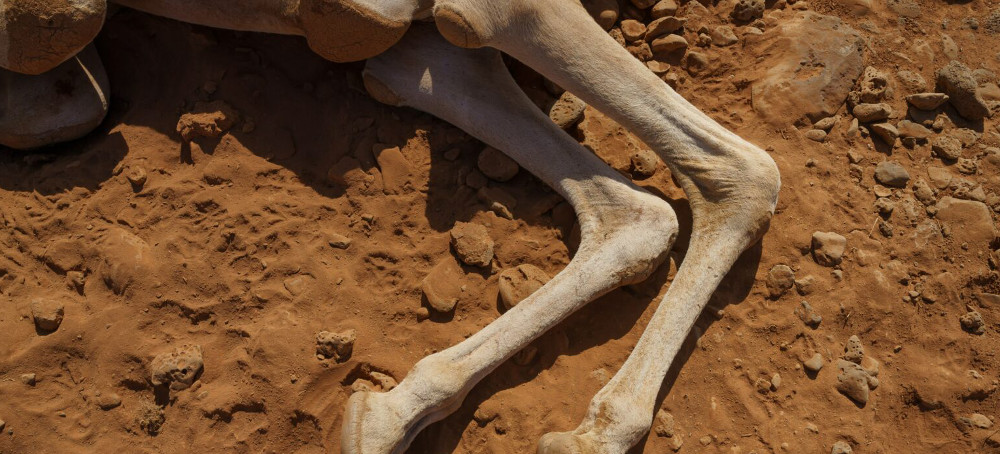 The body of a camel that died the day before of starvation lies near Marsabit, Kenya. (photo: Larry C. Price)
The body of a camel that died the day before of starvation lies near Marsabit, Kenya. (photo: Larry C. Price)
As a climate change-induced drought wears on, it’s putting more pressure on wildlife, livestock and people, with deadly consequences.
Isack Marembe and Kisham Makui study the animal’s body and everything around it, doing a roadside postmortem.
“A hyena,” Marembe says.
But the culprit wasn’t a hyena. The hyena just happened to pass by and take a bite from the dead wildebeest’s side. The killer was—it is—an enduring drought driven by warming ocean waters thousands of miles away.
Animals in this wildlife sanctuary have chewed every blade of grass down to a beige nub. There is nothing left. Another wildebeest, and another and another, have collapsed on the ground in a row, one by one, as if their demise had been choreographed. Those that haven’t died stand there, their heavy, doleful heads about to pull them forward to their knees. These creatures, so famous for trying to survive, are giving up.
On the road leading through the park more casualties come into view, a tally rising into the dozens, then hundreds. They become recognizable by their disintegrating shapes: Wildebeests are gray-brown lumps with quote-shaped horns. Gazelles, small piles of suede. Zebras, bloated disco-era carpets.
Then elephants. Their big frames are draped with their heavy wrinkly hides, like painters’ tarps, their compassionate long-lashed eyes now just ragged black holes. (Knock on the skin of a pachyderm that’s been dead for a few months, and the knuckles meet cement.)
Thousands of animals have died here this year, not from thirst but from lack of pasture and green shrubs, which usually are abundant and lush during this season but haven’t been for two years running. A third year of drought is on the way. There are so many dead animals here that vets and park rangers have volunteered to drag them away, out of sight from tourists.
Opportunists and scavengers are getting fat. “The hyenas are the only ones enjoying it now,” Marembe says.
The animals aren’t the only casualties.
Makui is a rancher from a nearby county who has lost dozens of his own animals—sheep and goats, mostly—to the drought. Marembe is a wildlife guide who lives outside the park and has spent 20 years showing tourists its complexities and splendor. As the animals the two men depend on die, their livelihoods go with them.
Both are Masai, members of a herding tribe. “Without animals, we are nothing,” Makui says matter-of-factly.
The men rumble through the park in a Land Cruiser, sharing their sorrow over the landscape around them.
“They are in mourning,” Marembe says, pointing to a cluster of wildebeest. “They are waiting to die.”
A few moments later, they spot a zebra as it rolls abruptly onto its back, kicking its legs in the air. “It’s dying,” the men exclaim.
But the zebra rolls around in the dust, then rights itself and stands up.
Makui smiles, relieved. “It’s just putting on sunscreen,” he says.
‘The Situation Is Very Dire’
Near the foot of Mount Kilimanjaro, Amboseli National Park spreads out across 151 square miles of plains and marsh, rivers and a seasonal lake.
The scene is one of the great pageants of the natural world. The giant mounded hulk of Kilimanjaro, the planet’s largest free-standing mountain, hovers above a flat expanse roamed by a children’s storybook of wild animals: gazelles, ostriches, flamingos, lions, buffalo, hippopotamuses.
The drought has turned this wildlife paradise into a wasteland. On the horizon, dust devils twirl and rise like smoke or incense. A rotting, cadaverine stench blows on the wind from every direction.
The park draws tens of thousands of tourists a year and is a major economic engine for the region. Now these tourists pop their heads through the roofs of safari trucks, or sit inside, jabbing at their phones and looking blankly out the window, wondering how the trip of a lifetime turned into a vigil.
Drivers occasionally stop their vehicles to talk to trackers or guides, hoping to get information about significant animal sightings. One stops Makui and Marembe, asking if they’ve seen an elusive giant elephant known as Greg. Another reports two lions up the road.
Rick Perkins and his daughter, Kathryn Faulke, are accomplished hobby photographers from Northern Virginia who came to Kenya to sharpen their skills. They left Amboseli heartbroken.
“In the morning we drove down to the park, and we saw a female elephant crush this tree down so her baby could eat the leaves,” Perkins recalled from his hotel in Nairobi. “When we came back in the afternoon, the baby elephant was dead. That was traumatic. Not just for us, but for our guides.”
What’s happening here is a consequence of a climate-change-fueled drought. But this grand national park also sits at the intersection of competing interests between humans and wildlife that are being aggravated by warming temperatures and lack of rain. Here, on grim display, is a portrait of how climate change exerts pressure on creatures—wild, domesticated and human—pushing them to clash over resources.
As more people have moved into the region, they’ve fenced off their farms and ranches, in part to protect their property, crops and animals from predators and grazers in the hope of guarding their own food supplies. But this has choked off ancient migratory routes or paths to watering holes that some animals have used for decades or more, and it has shrunk the area of pasture available to them. Amboseli has become an isolated sanctuary that can no longer offer relief when droughts grip the region.
“When animals are in a system where human impacts are becoming stronger, where there’s an increase in settlements and fenced roads, that doesn’t allow for safe crossing for wildlife,” said Joseph O. Ogutu, a senior statistician at the University of Hohenheim and an expert in wildlife population dynamics. “They’re not able to get to food or water.”
Wild animals, notably elephants in this area, break down fences and enter protected properties to eat crops and produce. When these animals encroach on private lands, property owners shoot or attempt to scare them off, sometimes with deadly consequences.
“The drought is forcing many animals to go closer to the villages where people are living, and many get killed,” Ogutu explained.
Added to this mix of shrinking resources and conflict is the recent economic downturn brought on by the Covid-19 pandemic and made worse by the drought. With emaciated livestock fetching lower prices, crops withering and jobs vanishing, illegal animal poaching has shot up across the country, putting yet another stress on the region’s animals.
“People become desperate, so they resort to killing wildlife,” Ogutu said. “The changing climate is not only affecting food security, it’s leading to more displacement and conflict. The situation is very dire.”
Pastoralists vs. Farmers
A tattered reflective vest hangs from a tree branch so customers can more easily spot the place where John Mwanzia Kithome sells cooking charcoal at the side of the road in the country’s northeast Garissa County, near the Somali border.
He and his friends burn wood, stoking it in a pit under the sand for a week to make the charred blocks that they put in feed bags and hawk to passersby.
This was not his work a year or two ago. Then he had a farm where he lived with his wife and three children.
“When it becomes dry in the north, they come down for water and then they chase us off the land,” he says. “They are killing us. The other day we buried nine people they shot with their guns. So many of our relatives have been killed. Our children are destitute.”
The “they” Kithome is referring to are pastoralists: herders who move through the arid landscape with their livestock, looking for pasture and living mostly off milk and meat. The “north” is Somalia.
“The pastoralists want people to move so the animals can eat,” said Kimanzi Mulonzia, who also sells charcoal here. “If the rain came today, life would get back to normal and the herders would go away and we could grow our food.”
The herders, some of whom are aligned with the militant extremist group al-Shabab, are rich, the men say. They have captured the ear of local politicians who side with them.
So the farmers retaliate. Kithome says they go after the thing that the pastoralists hold most precious and represent their greatest source of wealth: camels. Some farmers killed dozens of camels, slashing their necks and haunches with long knives, the local news recently reported.
“If you kill a human being, they don’t take much offense,” Kithome says with apparent disdain. “But if you kill a camel, they take much offense.”
Kithome and Mulonzia wonder why it hasn’t rained for so long, whether there are forces at work beyond nature.
“The rains have run away because of the war,” Kithome says. “If the Somalis kill one of us, we retaliate by killing a camel. So God is punishing all of us.”
The tensions between herders and farmers have simmered here for years, but the drought is applying yet more stress to an already volatile situation. This kind of dynamic, researchers and security experts say, has already played out in major ways and will continue.
After the Arab Spring uprisings erupted across much of the Arab world in 2010 and 2011, researchers and scholars traced the tensions back to climate change-induced droughts in major breadbasket countries.
The droughts led to food shortages and social unrest across the region, ultimately reshaping the Middle East and stoking instability across Europe. “Perhaps it even contributed to Brexit,” said Tim Benton, head of the Environment and Society Programme at the U.K. think tank Chatham House.
“That was a climate-induced food-price spike,” he said of the upheaval. “It illustrates the long-running ripple effects these sorts of things can have. The current crisis has the potential to be far more disruptive.”
When Matriarchs Die
Hundreds of people are gathered around a watering hole at the Sheldrick Wildlife Trust’s Elephant Orphanage in Nairobi. They’re waiting, cellphones ready, for the stars to show up.
Then, in what must be the cutest spectacle on Earth, 15 baby elephants come trampling down a path toward the crowd, where wheelbarrows of jumbo-size baby bottles filled with specially made formula await them.
Men in green jumpsuits feed each of them, the calves moving their trunks out of the way as they drink sloppily from the bottles. Edwin Lusichi, the head elephant keeper, begins to announce the elephants by name and by circumstance.
“On my left is Toka,” Lusichi says, as if he’s introducing his backing band. “She was found next to her mother who had died of drought.”
The crowd reaches out to pet the animals: their soft wrinkly skin with long, stiff hairs, the inside of their ears smooth like a luxury purse.
One baby was trapped in a snare, Lusichi says. Another was separated from its family when farmers shooed the elephants off their land. Another fell in a watering hole.
“Human-wildlife conflict is the number one reason” the elephants are orphaned, Lusichi says.
But drought is quickly catching up as the primary reason and “mother died of drought” is the most common refrain Lusichi recites today. In October alone, he says, the orphanage took in 10 babies because their mothers had died of drought-related starvation, leaving the calves with no milk or ability to forage for themselves. When matriarchs die, a herd may struggle to find the old paths to water. These maternal leaders are the ones that know the way, Lusichi says.
“They say elephants never forget,” he adds. “This is very true.”
It’s becoming difficult to disentangle one reason from the next: Did the calf fall in a watering hole because there’s so little water? Was the mother killed by a desperately poor ivory poacher? Was the young elephant separated from its family because its herd wandered onto a tomato farm for food?
“The reasons for them being orphaned are human-caused,” Lusichi says. “One way or another.”
It took 28 years to develop a formula of porridge, vitamins and minerals that sufficiently replaces their mothers’ milk. It takes aerial teams to find the stranded babies, then more people to truck them to the orphanage in Nairobi, where dozens of employees bring them back to life. They’re fed 24 liters of formula a day at three-hour intervals. When they’re ready to go back to the wild, the organization follows them for five years to ensure they’re accepted by their new families.
In its 45-year history, the Sheldrick orphanage has released nearly 300 orphaned elephants back into the wild.
Now there is less wild for them to return to.
Another Victim
Humans may see zebras as indistinct, part of a herd. But they are individuals. Each one is unique, the pattern on its coat like a fingerprint.
Marembe and Makui continue motoring through the park. Off the left side of the Land Cruiser, they see another zebra fall to the ground.
Follow us on facebook and twitter!
PO Box 2043 / Citrus Heights, CA 95611

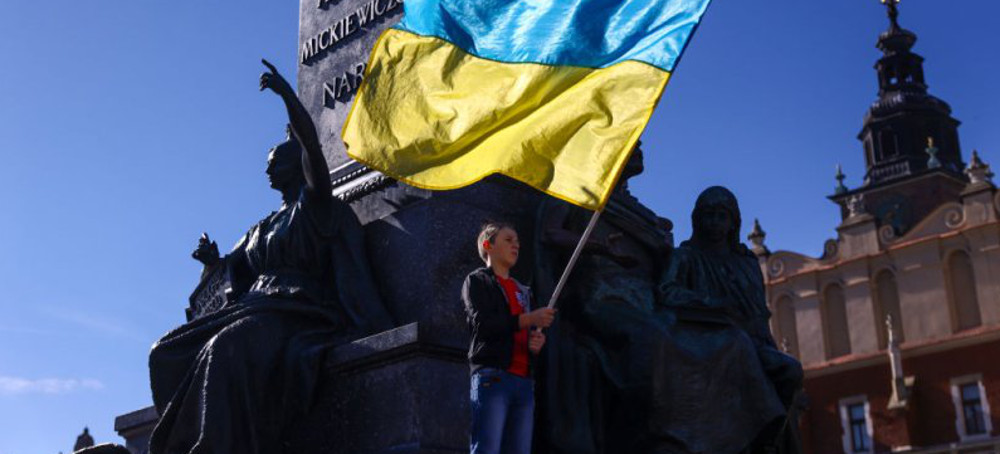

No comments:
Post a Comment
Note: Only a member of this blog may post a comment.